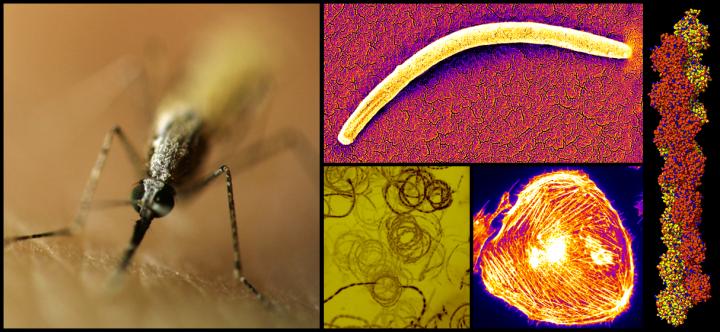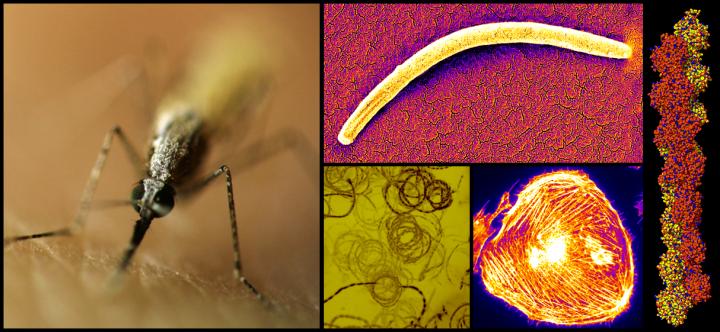
Credit: Heidelberg University Hospital/ HITS/ ZMBH
Malaria parasites of the genus Plasmodium move ten times faster through the skin than immune cells, whose job it is to capture such pathogens. Heidelberg scientists have now found a reason why the parasite is faster than its counterpart. They did this by studying actin, a protein that is important to the structure and movement of cells and that is built differently in parasites and mammals. The findings of Ross Douglas and his colleagues at the Centre for Infectious Diseases (Department of Parasitology) at Heidelberg University Hospital, the Centre for Molecular Biology at the University of Heidelberg (ZMBH), and the Heidelberg Institute for Theoretical Studies (HITS) are not only changing our understanding of a key component of all living cells, but they also provide information that could help in the discovery of new drugs.
How does the malaria parasite move so fast?
Like Lego blocks, which can be put together into long chains, actin is assembled into long rope-like structures called filaments. These filaments are important for the proper functioning of cells – such as muscle cells – and enable each of our movements. However, they also serve to enable immune system cells to move and capture invading pathogens. Likewise, they are of great importance for the movement of the malaria parasite. "Strangely enough, malaria parasites are ten times nimbler than the fastest of our immune cells and literally outrun our immune defences. If we understand this important difference in movement, we can target and stop the parasite," says Dr. Ross Douglas from the Heidelberg Centre for Infectious Diseases. A key issue in the paper published in the journal PLOS Biology is how the rate at which actin filaments are formed and broken down differs between parasites and mammals.
Mammal-parasite protein hybrids lead to new insights
It was known that certain sections of the actin protein differ between the parasite and mammals. To investigate the reasons behind the difference in speed, scientists replaced parts of the parasite protein with corresponding sections of protein from mammalian actin in the laboratory. "When we made these changes in the parasite, we noticed that some parasites could not survive at all and others suddenly hesitated when they moved," says Dr. Ross Douglas. To investigate the underlying mechanism, the participating scientists performed experiments and computer simulations ranging from modeling at the molecular level to observing the parasites in live animals. "High-performance computers were required for simulations to observe how the structure and dynamics of actin filaments change when individual sections are swapped," says Prof. Rebecca Wade, who heads research groups at the Heidelberg Institute for Theoretical Studies (HITS) and at the Centre for Molecular Biology (ZMBH) at Heidelberg University that investigate protein interactions via computer simulations and mathematical modelling.
These findings could now be used to discover chemical compounds that selectively target parasite actin and affect either the building or breakdown of the filament. "In this way, it could be possible to effectively stop the entire parasite," Dr. Ross Douglas summarizes. An example for this approach is tubulin, another type of protein which is involved in the building of the cytoskeleton via so-called microtubules. Medicines that target parasite microtubules – such as mebendazole – have been successfully used for decades to treat humans and animals for parasitic worms. This joint research project was partially funded by the innovation fund FRONTIER at Heidelberg University.
###
Media Contact:
Dr. Peter Saueressig
Heidelberg Institute for Theoretical Studies (HITS)
Phone. +49-6221- 533 245
Email: peter [email protected]
Doris Rübsam-Brodkorb
Heidelberg University Hospital
Phone +49 6221 56-5052
Email: [email protected]
Scientific Contact:
Dr. Ross Douglas
Centre for Infectious Diseases
Department of Parasitology
Phone. +49 6221-56-6546
Email: [email protected]
Prof. Dr. Rebecca Wade
Molecular and Cellular Modeling Group
Heidelberg Institute for Theoretical Studies (HITS)
and:
Zentrum für Molekulare Biologie (ZMBH), Heidelberg University
Phone +49-6221- 533 247
Email: [email protected]
Original publication:
Ross G. Douglas, Prajwal Nandekar, Julia-Elisabeth Aktories, Hirdesh Kumar, Rebekka Weber, Julia M. Sattler, Mirko Singer, Simone Lepper, S. Kashif Sadiq, Rebecca C. Wade, Friedrich Frischknecht.. Inter-subunit interactions drive divergent dynamics in mammalian and Plasmodium actin filaments, PLOS Biology, July 16, 2018 https://doi.org/10.1371/journal.pbio.2005345
About HITS
The Heidelberg Institute for Theoretical Studies (HITS) was established in 2010 by the physicist and SAP co-founder Klaus Tschira (1940-2015) and the Klaus Tschira Foundation as a private, non-profit research institute. HITS conducts basic research in the natural sciences, mathematics and computer science, with a focus on the processing, structuring, and analyzing of large amounts of complex data and the development of computational methods and software. The research fields range from molecular biology to astrophysics. The shareholders of HITS are the HITS Stiftung, which is a subsidiary of the Klaus Tschira Foundation, Heidelberg University and the Karlsruhe Institute of Technology (KIT). HITS also cooperates with other universities and research institutes and with industrial partners. The base funding of HITS is provided by the HITS Stiftung with funds received from the Klaus Tschira Foundation. The primary external funding agencies are the Federal Ministry of Education and Research (BMBF), the German Research Foundation (DFG), and the European Union.
About Heidelberg University Hospital and the Medical Faculty of Heidelberg University
Heidelberg University Hospital is one of the largest and most prestigious medical centers in Germany. The Medical Faculty of Heidelberg University belongs to the internationally most renowned biomedical research institutions in Europe. Both institutions have the common goal of developing new therapies and implementing them rapidly for patients. With about 13.000 employees, training and qualification is an important issue. Every year, around 65,000 patients are treated on an inpatient basis, 56.000 day patients and around 1.000.000 outpatient cases are treated in more than 50 clinics and departments with 2000 beds. Currently, about 3,700 future physicians are studying in Heidelberg; the reform Heidelberg Curriculum Medicinale (HeiCuMed) is one of the top medical training programs in Germany.
Media Contact
Peter Saueressig
[email protected]
49-622-153-3245
@HITStudies
Original Source
https://www.h-its.org/scientific-news/malaria_actin_en/ http://dx.doi.org/10.1371/journal.pbio.2005345





